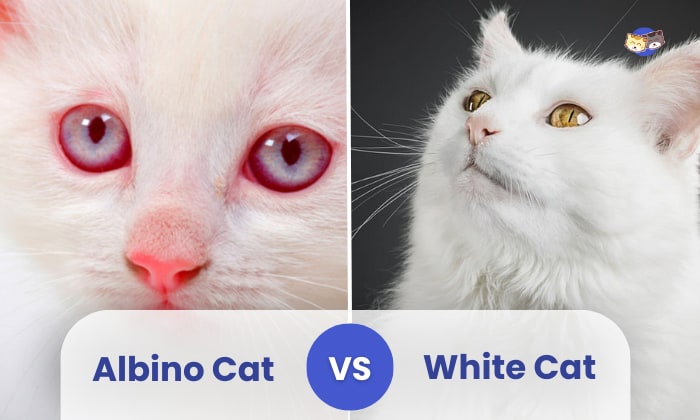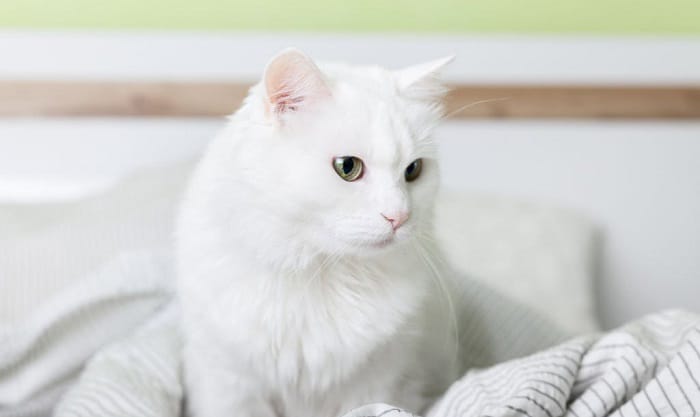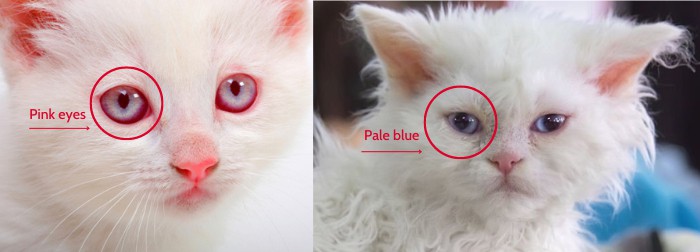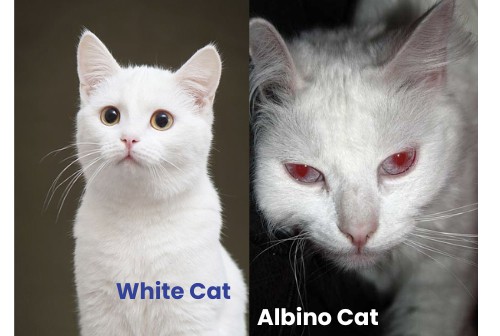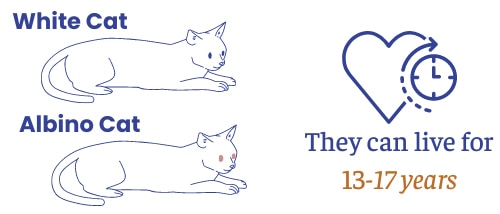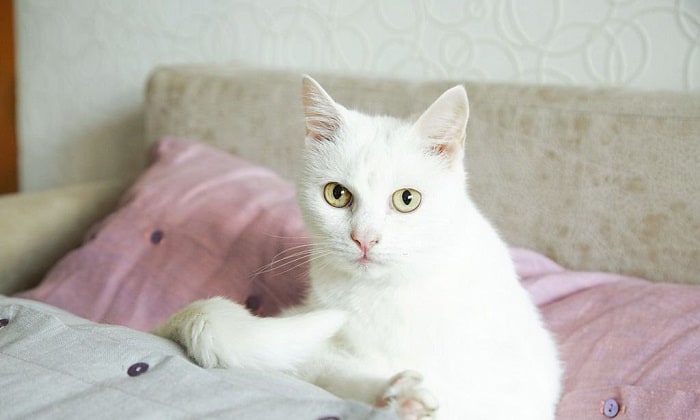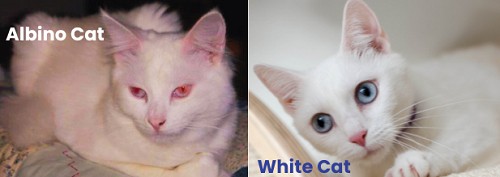Felines come in remarkable colors and patterns. However, among the most captivating are white cats. White felines feature unique beauty with their pristine coats that embody elegance. But, it is worth noting that not all white cats are created equal.
Some possess a genetic disorder called albinism, which sets them apart from their white feline counterparts.
This article will dive into the fascinating world of albino cat vs white cat.
| Albino cat | White cat | |
| Fur | White or creamy coat | Pure white coat |
| Skin | Rather pinkish | Fair skin (similar to humans) |
| Eyes | Mostly pink or pale blue | Mostly green, blue, and amber |
| Skin condition | Rather weak
Vulnerable to sunburn and skin cancer |
More healthy skin |
| Life span | 13 to 17 years | 13 to 17 years |
Table of Contents
What Are the Characteristics of White Cats?
Unlike the common misconception, pure white cats have melanin. Melanin is the pigment that determines skin, fur, and eye color. However, the melanin in their bodies is less than that of felines with various color patterns.
The gene makeup of white cats has a dominant white gene. Other genes make up their eye color, but the dominant white gene wins. As a result, the fur of white kittens has no pigment, while their eyes still have pigmentation. This characteristic is common in white cats with blue eyes.
In addition, white cat skin may have dark spots, which are melanin pigmentations.
What Does an Albino Cat Look Like?
Albino kittens have a rare genetic condition known as albinism. This condition is characterized by the inability to produce melanin.
If you see a white cat with pink eyes or pale blue irises, they undoubtedly have albinism. They may also experience visual impairments and sensitivity to light.
The lack of melanin in albino cats’ skin and fur makes them extra sensitive to ultraviolet rays. As a result, they are susceptible to skin damage like sunburn.
Furthermore, albino cats might have pinkish skin as a reflection of their blood flow.
How Rare Are Albino Cats?
Albino cats are a lot more rare than felines with normal pigmentation. In fact, only about 2% of the feline population have albinism.
However, it’s important to note that the rarity can vary depending on the feline’s breed and population. Some breeds may have a slightly higher incidence of albino cats, while others may have very few or none at all.
How to Tell if a Cat is Albino or White
One of the best ways to differentiate an albino cat from a white cat is by looking at its eye color. As mentioned, albino cats have either pink or pale blue eyes caused by their lack of melanin.
But if you encounter a cat with white eyes, it is worth noting that it is not an albino. Instead, its white eyes are caused by chronic inflammation of the cornea.
Meanwhile, normal white cats have eyes with colors similar to the eyes of patterned cats. Their skin is also pale in color rather than light pink, which is another characteristic of albino felines.
Differences Between Albino and White Cats
Below are the differences between albino and white felines:
1. Physical Difference
The most notable physical difference between albino and white fur cats is their skin and fur pigmentation.
White cats have pristine white coats. They also have eyes with a range of colors, such as green, blue, and amber. Some even have different-colored eyes, a condition called heterochromia.
Albino felines, on the other hand, have fur that is either white or a bit creamy. Their eyes are usually light pink, but some are also pale blue.
The skin color of these cats is also different. White cats have pale skin, just like fair-skinned humans. Meanwhile, albino cats have pinkish skin.
2. Genetics
As mentioned, white cat breeds have melanin pigmentation. However, their dominant white gene prevents them from producing enough melanin to show their actual color.
Albino cats cannot produce melanin, as their tyrosinase (TYR) genes have a rare mutation. This mutation leads to the lack of pigmentation in their skin, fur, and eyes.
3. Health Issues
Albino cats are susceptible to various skin problems, especially those that affect their skin. Since they lack melanin, albino felines are prone to sunburn and skin cancer.
They may also acquire visual impairments, with nystagmus or involuntary eye movements being the most common.
Meanwhile, white cats are normal, so they don’t usually experience health-related issues.
4. Temperament And Personality
The temperament of albino and white cats depends on their breeds. But as some albino felines have reduced hearing, they tend to be skittish when they don’t notice people or other animals approaching them.
5. Lifespan
Albino and white cats have a similar lifespan. They can live for 13 to 17 years or even longer if properly cared for.
However, the susceptibility of albino cats to various health conditions requires special care.
White Fur Cats or Albino Cats: Which Makes a Better Pet?
The choice between albino and white cats depends on your lifestyle, preference, and ability to provide your pet’s care.
If it is your first time caring for a cat, a white cat with normal pigmentation is ideal. They do not require special care, as they are not prone to pigmentation-related health conditions.
Therefore, caring for a white cat is easier than caring for an albino cat.
But, if you are used to handling felines and know how to handle their needs, you can adopt a rare feline, such as an albino tabby cat. However, it is worth noting that albino felines require more care than normal white cats.
So, you must ensure you can dedicate time and effort to tending to their needs.
1. Pros and Cons of Having a White Cat
Pros
- Aesthetic Appeal. White cats are often admired for their elegant appearance. Their white fur can be visually striking, allowing them to stand out among other pets.
- Unique Patterns. Some white cats have unique patterns or markings, such as spots, patches, or bicolor patterns. These markings make them visually appealing and unique.
- Eye Color Variety. As mentioned, white cats can have a range of eye colors. For instance, a snow white cat with brown eyes looks captivating and pristine.
- Low Risk For Health Issues. White cats have normal pigmentation and are not sensitive to light and UV rays. This fact makes them easy to care for.
Cons
- Stains and Maintenance. White fur shows dirt, stains, and shedding more visibly compared to other coat colors. Regular grooming and cleaning may be required to keep their fur looking clean and tidy.
- Exposure to cat dander can cause allergic reactions such as sneezing, itching, or respiratory issues in some people.
- White cats, especially those with long and thick coats, are prone to shedding like other cats.
2. Pros and Cons of Having an Albino Cat
Pros
- Unique Appearance. Albino cats have a striking appearance due to their lack of pigmentation, which can be quite captivating.
- Rare and Special. Albino cats are relatively rare, and having one can make you feel like you have a one-of-a-kind companion.
- Potential for Special Bond. The distinctive features of an albino cat may help foster a deeper bond between you and your pet. The reason is that you may feel a sense of responsibility and protectiveness towards them.
Cons
- Health Issues. Albino cats may have a higher risk of sunburn, skin cancer, and vision problems due to their lack of protective pigmentation.
- Sensitivity to Light. Albino cats typically have sensitive eyes and are more prone to discomfort or irritation when exposed to bright sunlight or harsh lighting conditions.
- Potential for Genetic Issues. If you plan on breeding albino cats, it is important to consider the potential health problems that their offspring may have. You can opt for albino male white cats if you don’t want your pet to produce kittens with the same genetic condition.
Tips for Taking Care of Albino and White Cats
Despite their genetic mutation, caring for an albino feline is almost the same as taking care of a normal white cat.
- Provide your pet with a safe and stimulating environment. Your feline should be comfortable under your care, whether it is an albino or a normal white cat.
- Provide a healthy diet. Feed your pet with high-quality cat food. If you are not sure what food will suit your pet, consulting a veterinarian is ideal.
- Regular vet care. It is important to bring your cat to a veterinarian regularly. This way, you can monitor your pet’s health and provide it with the medicine and vitamins it needs.
- Grooming. Brush your cat regularly to remove loose hair and prevent matting. Long-haired cats may require more frequent grooming.
- Keep your cat away from the sun. If you are taking care of an albino or partial albino cat, keeping it away from direct sunlight is crucial to keeping it healthy.
Frequently Asked Questions
How much are albino cats worth?
Albino cats are extremely rare, so breeders cannot reproduce them by mating two albino felines. So, there is no specific cat price or market value for these cats.
Are white cats albino cats?
Not all white cats are albino cats. Most white cats only have a dominant gene that turns their fur white.
Are all white cats rare?
Pure white cats are pretty rare. They make up only about 5% of the total feline population.
Conclusion
Albino Cat vs white cat – these two felines may look similar but have different genetic makeup. Regardless of this fact, there are many customs and superstitions that revolve around pure white cats.
In some cultures, people see white felines as bringers of luck, making them popular household pets. But no matter if a cat is white or patterned, they bring luck to people who know how to love and care for them.
Read more:

I am Amy Sawy, a Doctor of Veterinary Medicine (DVM) graduate from the University of Kansas. y husband, Dr. Plummer, and I own a veterinary clinic in Phillipsburg, Kansas. In addition to my professional background, I am a devoted pet owner myself, with a household that includes dogs, rodents, and most notably, cats – a total of five felines in my home.
In 2020, I joined an organization as a professional writer, leveraging my experience and collaborating with my team to deliver the most valuable information for your cat’s care.


